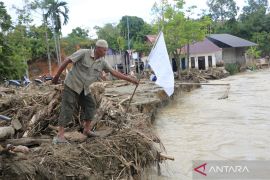Jakarta (ANTARA) - The government formulates various adaptation and mitigation actions to handle weather anomalies that can potentially cause a food crisis.
Head of the National Research and Innovation Agency's (BRIN's) Climate and Atmosphere Research Center Aris Pramudia, through a statement, Wednesday, noted that weather anomalies will occur in Indonesia throughout 2023 until 2024.
"El Niño, which is closely related to drought, and La Niña, which is closely related to heavy rainfall, will affect the planting and harvesting seasons, which affect the decline in agriculture productivity," he stated.
La Niña and El Niño are phenomena caused by climate change, he stated.
El Niño is an phenomenon in which the seawater temperature in the Pacific Ocean rises above the average normal temperature.
Meanwhile, La Niña is an anomaly that involves a decline in seawater temperatures in the Pacific Ocean under the below-average temperature of the surrounding region.
When La Niña occurs, winds blow stronger than usual along the Equator above the Pacific Ocean from South America to Asia.
Such trade winds cause warm waters to gather off the coast of Asia that elevate the seawater surface. Meanwhile, in the east, this condition causes cold water to rise to the surface.
"Meanwhile, when El Niño occurs, the opposite happens. Weaker trade winds cause warm water to flow again, thereby decreasing the amount of cold water rising to the surface," he noted.
Pramudia highlighted several adaptation and mitigation actions formulated to face this weather anomaly that include monitoring information on the rainfall forecast, including potential hydrometeorological disasters.
The other actions encompass the implementation of an accurate planting schedule and adaptive varieties, climate change impact handling movement, and accurate utilization of rainwater harvesting infrastructure.
Food Crop Director General at the Agriculture Ministry Suwandi outlined several other steps taken by the government to handle the risk of climate crisis that affects food crops in Indonesia.
These include the implementation of quick win methods starting from the mapping of flood-prone regions during the rainy season and drying equipment usage and insurance usage for farmers in the case of harvest failure.
Moreover, the government identifies varieties with low tolerance to water and drought and improves the quality of human resources and research, he stated.
Related news: Weather anomaly triggers frost in Dieng during rainy season
Related news: Agency asks regions to prepare weather anomaly plans
Related news: Asia monsoon may trigger extreme weather, BMKG cautions










